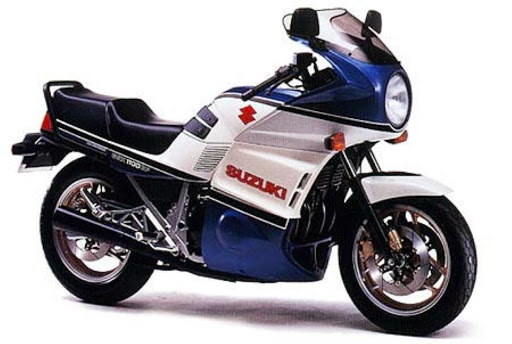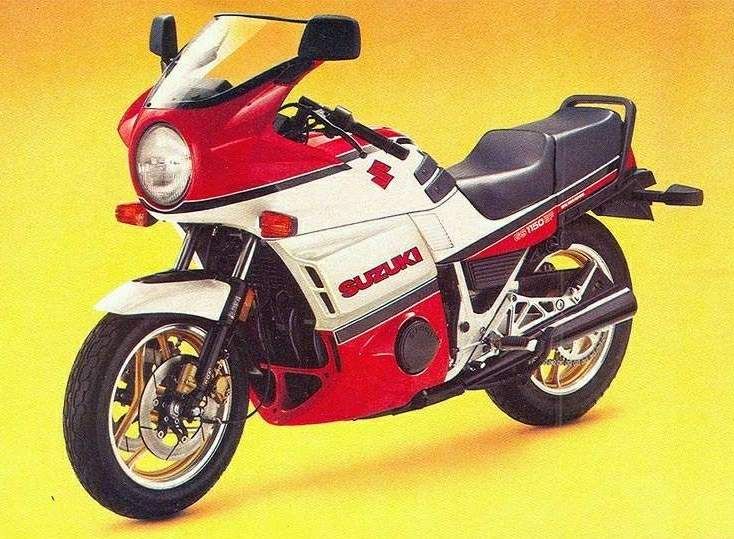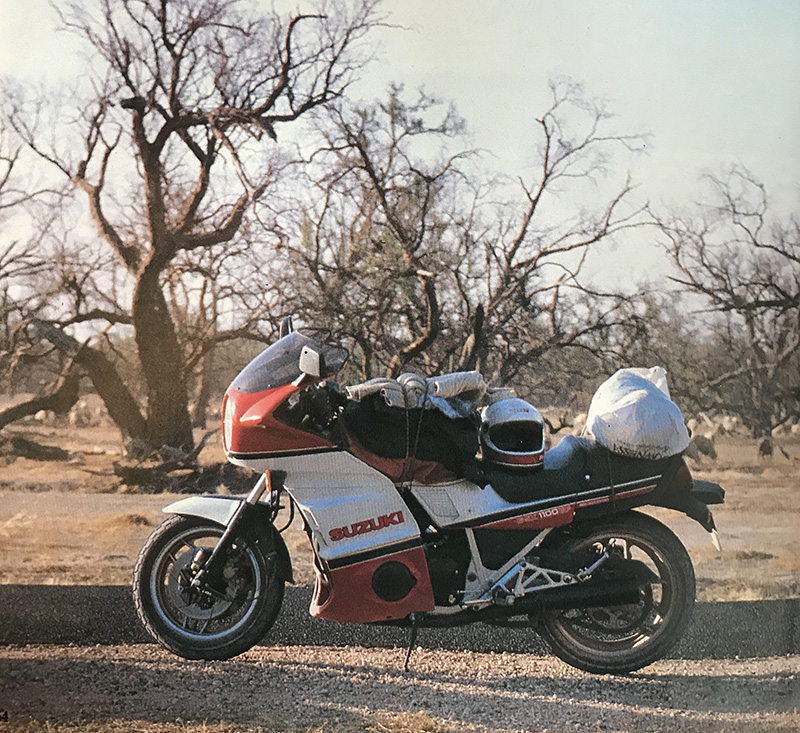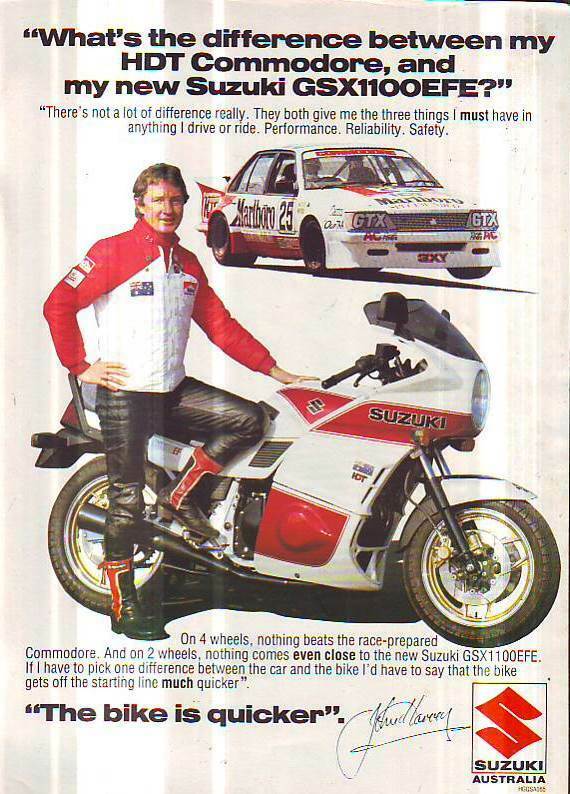Motorcycle Investor mag
Subscribe to our free email news

Mighty bikes – Suzuki GSX1100EF
(by Guy ‘Guido’ Allen, May 2021)

Brute Force
Fast but flawed? Suzuki's big sports tourer gained some notoriety thanks to a TV hatchet job, but was nevertheless a formidable performer
Back in the 1980s, it was unthinkable that a motorcycle would attract the attention of a mainstream current affairs TV show. However that dubious distinction landed on Suzuki's GSX1100EF series, through a segment on long-running Nine network show A Current Affair.
The gist of the segment was these bikes were dangerously unstable and wobbled uncontrollably if you took your hands off the 'bars. As so often happens when programs of this nature get into an area they don't fully understand, the content proved to be more hype than reality and didn't gel with the experience of most owners.
We'll come back to the handling of the series shortly, but let's first have a look at the machine in question.
This was a natural shift from the preceding E through to ES series, with the centrepiece being an upgrade of the by now famously willing Suzuki 16-valve inline four. Air-cooled, it was bumped up in capacity to 1135cc. Initially (in 1984) it claimed 114 horses, but with the launch of the EFF variant in 1985 that number had been tweaked to 124.
At the time, the latter figure was enough to produce some truly awe-inspiring performances. We're talking consistent low-11 second times on the strip, sometimes just cracking into the high tens, with teminal speeds of around 200km/h. Top speed was more like 240km/h. Fast.
The ratios chosen for the five-speed transmission worked well, though riders of the first EFE version reported an annoying buzz at highway speeds, circa 100-110km/h, which was adressed with the EFF.
As for the chassis, we're talking a square-section twin-loop steel frame, with conventional fork up front and monoshock rear. This was the eighties, so we had a couple of then-fashionable features: a 16-inch front wheel and hydraulic anti-dive.
That wheel size was common to what Grand Prix bikes of the day were running and was controversial. Stability, or lack of it, was the concern with commentators saying the rim size was too small for the road.
However there were 16-inch-shod examples like the Kawasaki GPz900R that had an excellent reputation for stability. On models where there were question marks, the issue was as much makers pushing the envelope with the entire package rather than any single factor.
This is something highlighted by long-term industry player Mick Hone, who has retailed Suzukis for decades and was running a dominant national superbike team during this period. "These bikes were working on the outer margins for their time," he points out, while emphasising that didn't make them dangerous.

His view is confirmed by a long-term test report by Australian Motorcycle News, published in 1985. Ian Baker reported on an EFF which had so far done 8500km in the hands of the magazine. He describes where and how the bike could get unruly.
"Take your hands off the handlebars while decelerating from about 85km/h and the 'bars begin an oscillation that quickly degenerates...the funny thing is you couldn't really call the behaviour dangerous. The bike keeps going in a straight line and, provided you don't leave it too long to grab the 'bars again, seems never to threaten to throw you off."
As Mick Hone pointed out, while this sort of behaviour might have been a novelty back then, it's far less so today and is common in one form or another on lots of modern bikes. His advice: "Ride with your hands on the handlebars." Fair enough.
Baker's other observation was that high-speed cornering sometimes had a wrinkle. "Most of the time it is fine, but every now and then it will strike a mound in the roadway during 140km/h-plus sweepers and lurch into a wobble. A distracting habit. It settles down quickly and, again, never looked like throwing anyone off." My own observations were that such behaviour was common across a lot of big motorcycles of the era – and later.
Hone says the key to getting the best out of the series is two-fold. First, stick with the original tyre sizes. Fitting wider than stock rubber, particularly on the rear, hurts the handling. The other is hardly surprising: worn tyres see the handling deteriorate, so don't be mean when it comes to changing it over.
Something Baker added was that the GSX gave every impression of being incredibly robust – something that's supported by long-term owners of the series. One such is Dave Milligan of Get Routed tours, who commented, "Did over 200,000km on mine. Great days!"
Hone recalls he had customers who would wear one out and come back for another, keeping the first for spares.
My own experiences on the model back up the positive views of many owners. It was an absolute monster in performance terms, handled well enough for its day and had that bullet-proof feel that could very easily get under the skin of the owner.
This felt like a big motorcycle and was comfortable for quick long-distance runs. Braking was okay for the day, and acceptable now, but is nothing like a modern set-up.
While the styling is very eighties, it also gives the bike real presence – something they've maintaned even to this day. Sadly you don't see many getting around. They haven't really hit the collector radar and the majority that were sold here were literally worn out.
Earlier GSX1100Es and Katanas are very much accepted as collectibles and are priced accordingly, but later versions like this haven't yet garnered the same support. If you did find a good one, it would be sorely tempting to grab it. They have a real brute-force appeal while potentially being a very reliable and stress-free old bike.
***

Above: Australian ad featuring legendary racer and HDT/HSV exec John Harvey.
Resources
Check out Suzukicycles.org, an excellent resource for Suzuki of this era.
Period road test of an EFE by Motorcyclist mag at Motorcycle Specs.
Variants

Suzuki UK imported naked versions of the EF series, which didn't make it to Australia. Half-fairing versions were also available in some markets.
***
Ratings
Good
Fast
Bulletproof
Very eighties
Not so good
Keep your hands on the 'bars!
Hard to find in good shape
SPECS:
Suzuki GSX1100EFF 1985
ENGINE:
TYPE: Air-cooled, four-valves-per-cylinder, inline four
CAPACITY: 1135cc
BORE & STROKE: 74 x 66mm
COMPRESSION RATIO: 9.7:1
FUEL SYSTEM: 4 x Mikuni 36mm carburettors
TRANSMISSION:
TYPE: Five-speed, constant-mesh,
FINAL DRIVE: Chain
CHASSIS & RUNNING GEAR:
FRAME TYPE: Steel twin-loop
FRONT SUSPENSION: 37mmKayaba air-assist fork, preload and compression adjustment, anti-dive
REAR SUSPENSION: Kayaba monoshock with preload and rebound adjustment
FRONT BRAKE: 275mm discs with 2-piston calipers
REAR BRAKE: 275mm disc with 1-piston caliper
DIMENSIONS & CAPACITIES:
DRY/WET WEIGHT: 238/256kg
SEAT HEIGHT: 835mm
WHEELBASE: 1550mm
FUEL CAPACITY: 20lt
TYRES:
FRONT: 110/90-V16
REAR: 130/90-V17
PERFORMANCE:
POWER: 124hp 92kW @ 8500rpm
TORQUE: 105Nm @ 6500rpm
OTHER STUFF:
PRICE $6200 plus on-road costs
-------------------------------------------------
Produced by AllMoto abn 61 400 694 722
Privacy: we do not collect cookies or any other data.

Archives
Contact





